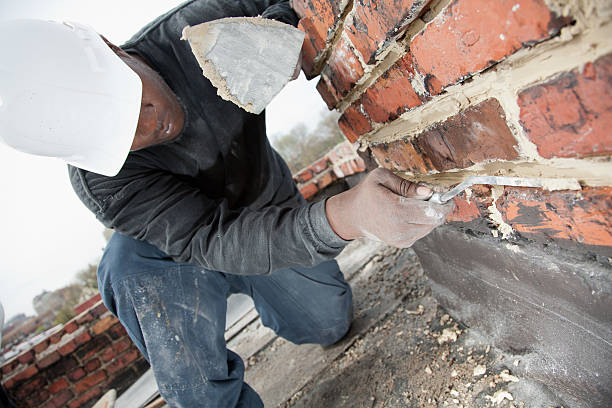Trustworthy Tuckpointing Services for Improving Block and Rock Surfaces
Trustworthy Tuckpointing Services for Improving Block and Rock Surfaces
Blog Article
Opening the Keys of Sustainable Masonry Construction Practices for Eco-Friendly Structures
In the realm of modern building, the quest of lasting practices has become paramount. Among the myriad approaches to green structure, lasting masonry building and construction sticks out as a time-tested and sturdy method that holds a wealth of untapped possibility. From the choice of products to cutting-edge building and construction methods, the secrets to attaining sustainability within stonework building are complex and fascinating. By exploring the advantages, products, techniques, and future patterns of sustainable masonry, a deeper understanding of exactly how these methods can shape the future of eco-friendly structures emerges.
Advantages of Sustainable Stonework Construction
Embracing sustainable stonework building techniques not just reduces ecological impact but likewise supplies long-term economic benefits to contractors and neighborhoods. By making use of materials like recycled blocks, blocks, and stones, building contractors can significantly decrease the carbon impact of their jobs while promoting resource efficiency. In addition, sustainable masonry building techniques, such as proper insulation and thermal mass buildings, can enhance power performance within structures, resulting in minimized functional costs in time.
Furthermore, the longevity and durability of stonework frameworks add to lasting financial benefits. Buildings built utilizing lasting masonry methods often need much less maintenance and repair, translating to cost financial savings for builders and property proprietors. The long life of masonry materials also guarantees that frameworks continue to be steady and secure, decreasing the need for regular restorations or substitutes.
Eco-Friendly Stonework Products
Making use of environmentally friendly stonework products is an essential action in the direction of enhancing the sustainability of building and construction methods and lessening environmental impact while maximizing long-lasting financial benefits. Sustainable masonry materials are sourced, generated, and used in a fashion that minimizes overall ecological impact. Sustainable concrete obstructs include recycled aggregates and might feature improved insulation buildings, contributing to energy efficiency in structures.
Furthermore, natural materials like adobe, rammed earth, and straw bales provide superb thermal mass buildings, lowering the need for home heating and cooling down power. These products are frequently locally readily available, promoting regional economic climates and minimizing transportation-related carbon exhausts. By choosing environmentally friendly stonework materials, building tasks can substantially lower their ecological footprint and add to the creation of much healthier, much more sustainable developed settings.
Energy-Efficient Masonry Techniques
Energy efficiency plays a critical role in boosting the sustainability of masonry building techniques. One vital energy-efficient stonework technique is the use of thermal mass, which involves incorporating thick materials like concrete or brick into the structure's structure to soak up and save warmth.

Innovations in Lasting Stonework
Recent advancements in sustainable stonework practices have actually caused ingenious techniques that are reshaping the building and construction sector. One such development is the growth of self-healing concrete, which utilizes bacteria try these out installed within the concrete to recover cracks autonomously. This innovation not only minimizes maintenance prices but likewise improves the durability of stonework frameworks, contributing to their sustainability.
One more noteworthy technology is using recycled aggregates in masonry building - masonry contractor. By including products such as crushed ceramic waste or recycled glass into concrete blends, contractors can minimize the ecological influence of building and construction jobs while keeping structural integrity. This practice not just draws away waste from land fills but likewise preserves natural sources, making it a vital improvement in sustainable masonry construction
Additionally, the integration of digital design tools, such as Building Details Modeling (BIM), is reinventing the way masonry structures are intended and constructed. BIM enables more exact computations, decreased material wastefulness, and boosted power performance, eventually causing more sustainable building practices. These advancements collectively represent an appealing future for lasting stonework building in the age of environmentally friendly structures.
Future Trends in Masonry Sustainability
With the innovative strides made in lasting stonework practices, the future trends in masonry sustainability are positioned to additional transform the building industry. Among the crucial trends forming the future of stonework sustainability is the raised assimilation of modern technology. Improvements such as Building Info Modeling (BIM) and digital truth simulations are being utilized to maximize masonry building procedures, leading to lowered material waste and enhanced power effectiveness in buildings.
In addition, the growth of novel lasting materials is readied to play a considerable role in boosting the eco-friendliness of masonry building and construction. masonry contractor. Technologies like self-healing concrete, recycled accumulations, and bio-based binders are acquiring grip for their ability to reduce ecological impact while maintaining architectural stability

Conclusion
To conclude, sustainable masonry building methods use many benefits for environmentally friendly buildings. By using eco-friendly products and energy-efficient view publisher site techniques, masonry can add to a more sustainable developed atmosphere. Technologies in lasting stonework are continuously being developed to even more enhance the environmental efficiency of buildings. Looking in the direction of the future, the pattern of masonry sustainability is expected to grow, bring about more eco-friendly and energy-efficient construction techniques in the years to come.
Report this page